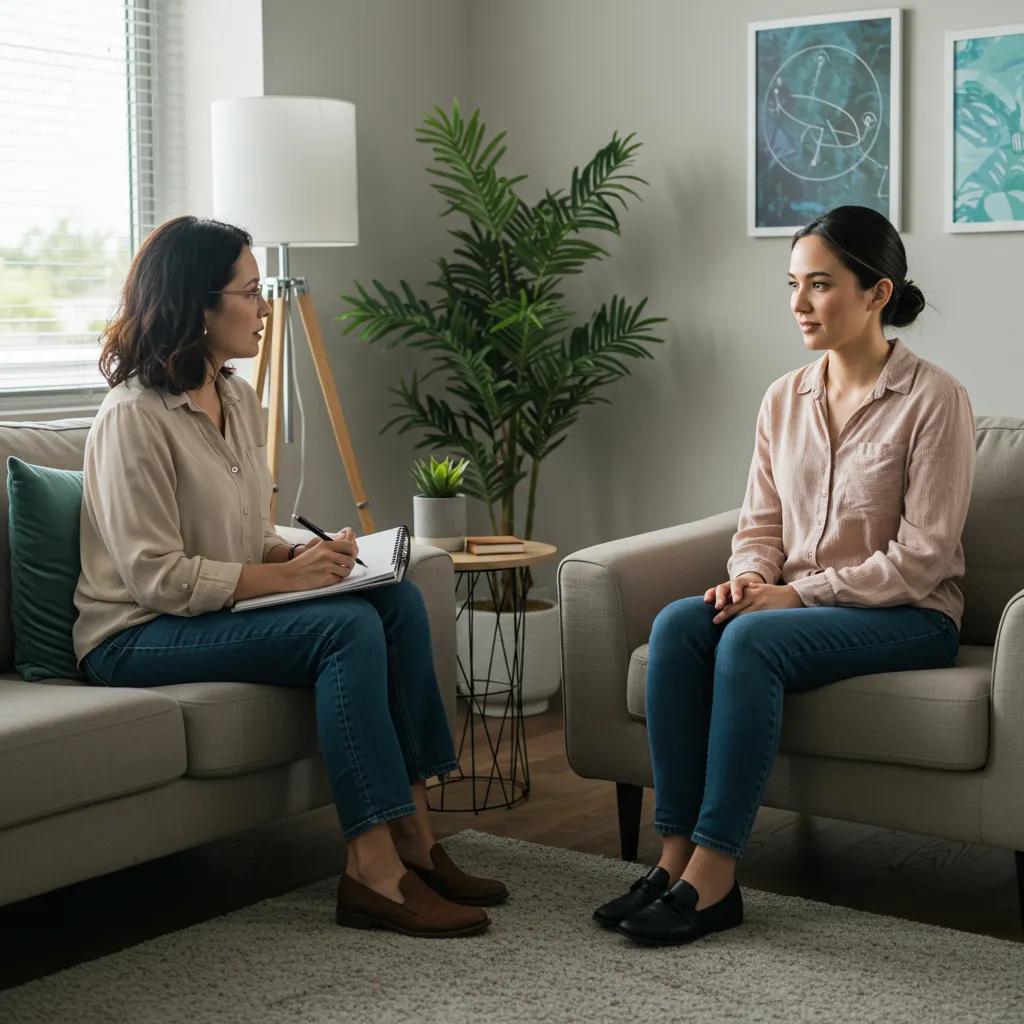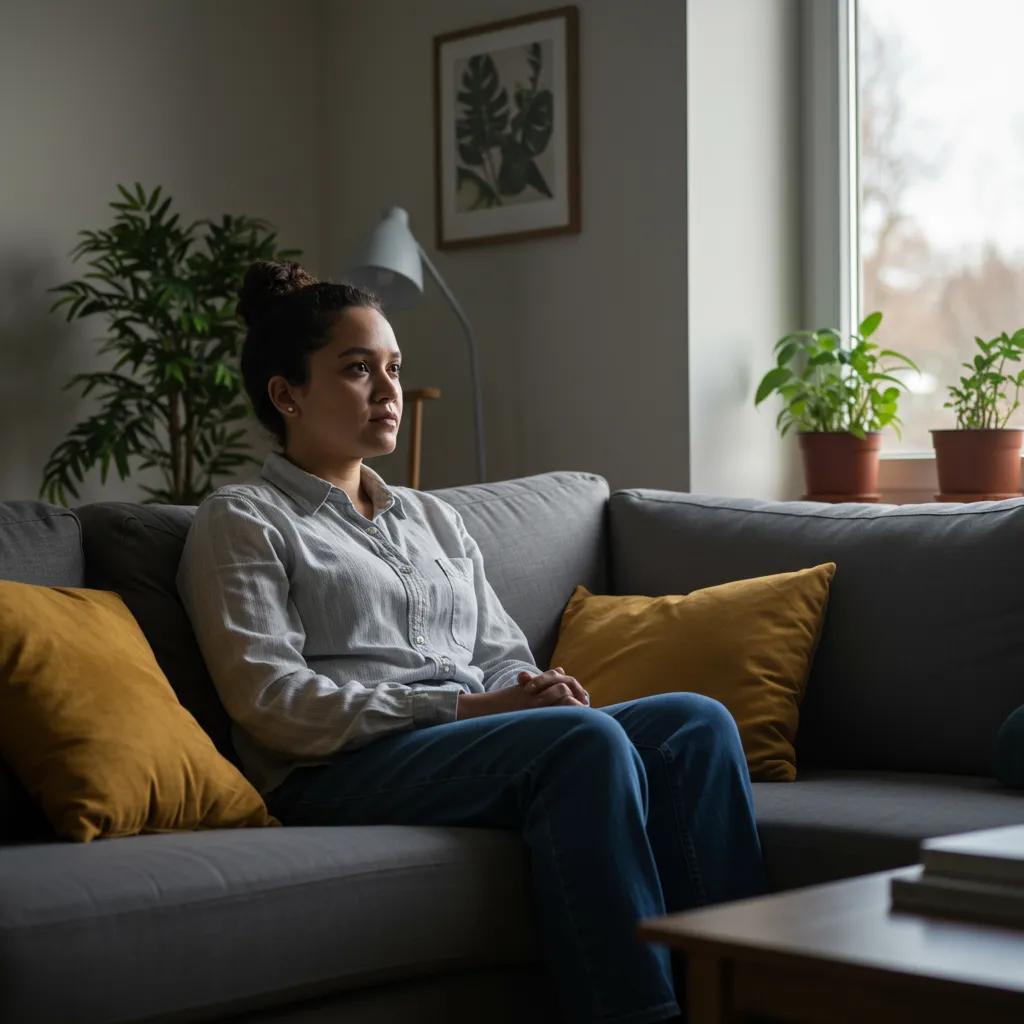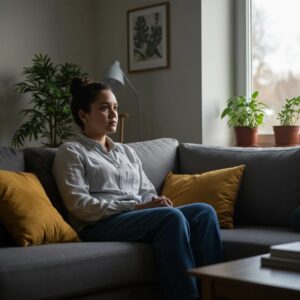Agoraphobia Explained: Signs, Causes, and Effective Treatment Options
Agoraphobia is an anxiety disorder characterized by intense fear and avoidance of situations where escape might be difficult or help unavailable, and it often leads to marked functional impairment. This article explains agoraphobia symptoms, underlying causes, diagnostic distinctions from panic disorder, and the most effective treatment for agoraphobia, including both outpatient therapies and intensive residential options.
Readers will learn clear signs to watch for, the mechanisms that reinforce avoidance, practical coping strategies that can reduce day-to-day distress, and when to pursue higher levels of care. Throughout, the focus remains on evidence-based interventions such as CBT and exposure therapy while also outlining medication roles and adjunctive approaches like DBT and ACT. The piece closes by describing how residential treatment can support recovery in Orange County, CA, and by offering guidance on when professional help is indicated.
What Are the Key Symptoms of Agoraphobia?
Agoraphobia manifests as a persistent fear of places or situations where escape may be difficult, often accompanied by panic-like physical symptoms and strong avoidance behaviors that reduce quality of life. This mechanism—conditioned fear that generalizes across environments—creates anticipatory anxiety that drives avoidance and limits activities such as leaving home, using public transportation, or attending crowded venues. Identifying core agoraphobia symptoms early improves access to effective treatment for agoraphobia and reduces long-term disability. Recognizing these signs also clarifies when to use stepped-care approaches, from outpatient CBT to more intensive residential treatment for severe cases.
Which Physical and Behavioral Signs Indicate Agoraphobia?

Common agoraphobia symptoms combine somatic panic signs with behavioral avoidance and cognitive worry, and they frequently present together. Physical symptoms often include heart palpitations, sweating, dizziness, shortness of breath, and gastrointestinal upset during or in anticipation of feared situations. Behavioral signs include repeatedly avoiding outings alone, needing a companion to leave home, or restricting activities to a limited “safe” zone; these avoidance patterns reinforce fear through negative reinforcement. Cognitive features—worry about losing control or being unable to escape—sustain hypervigilance and anticipatory anxiety, increasing the likelihood of comorbid depression or substance use. Understanding these patterns explains why exposure-based strategies and mobility-focused assessments are central to treatment.
How Does Agoraphobia Affect Daily Life and Mental Health?
Agoraphobia frequently produces marked functional impairment across work, social, and family domains, reducing independence and increasing reliance on others for basic tasks. Many individuals report difficulty maintaining employment, attending classes, or fulfilling caregiver responsibilities because of anticipatory anxiety and avoidance of critical environments. Comorbid conditions—especially panic disorder and major depressive disorder—are common and compound disability, while prolonged isolation can worsen mood and increase suicidal ideation risk in severe cases. Early intervention that targets avoidance and restores activity often improves social functioning and lowers the chance of chronic disability, which leads to consideration of structured therapies next.
- Key symptoms that suggest agoraphobia include persistent avoidance of feared situations, recurrent panic-like physical symptoms, and significant interference with daily functioning.
- Early recognition and intervention can interrupt the avoidance-conditioning cycle and improve long-term outcomes.
This list highlights the principal manifestations to monitor when assessing someone for agoraphobia.
What Causes Agoraphobia and Who Is at Risk?
Agoraphobia arises through interacting genetic, neurobiological, and learning-based mechanisms that increase sensitivity to panic symptoms and promote avoidance learning. Genetic predisposition and temperament can create a vulnerability to anxiety, while neurobiological factors like heightened autonomic reactivity amplify somatic sensations that are misinterpreted as dangerous. Psychological conditioning—where panic attacks or intense distress in certain settings become linked to those contexts—drives anticipatory fear and avoidance, which then generalizes to additional places. Recognizing these causal pathways clarifies why treatments that target both cognition and behavior, such as CBT and exposure therapy for agoraphobia, are effective at reversing learned avoidance.
What Genetic, Environmental, and Psychological Factors Contribute to Agoraphobia?
Research indicates a heritable component to anxiety disorders, and family history increases relative risk, though specific genes interact with environment to shape outcome. Environmental contributors such as traumatic events, chronic stress, or early life adversity can sensitize fear circuitry and accelerate conditioning processes that lead to agoraphobia. Psychological mechanisms—catastrophic misinterpretation of bodily sensations and avoidance learning—explain how acute panic can evolve into pervasive situational fear. These combined influences show why multi-modal interventions addressing biology, cognition, and behavior produce the best outcomes in treatment for agoraphobia.
Research exploring the interplay of metacognitive beliefs and functional impairment in agoraphobia highlights the importance of cognitive processes in the disorder’s impact.
How Do Risk Factors Like Age, Gender, and Trauma Influence Agoraphobia Development?
Epidemiological patterns show higher lifetime prevalence of agoraphobia among women and typically earlier onset in young adulthood, suggesting developmental timing and gender-related factors shape vulnerability. Trauma and significant life stressors can act as triggers that precipitate panic attacks in predisposed individuals, accelerating the transition from isolated panic to broad avoidance. Comorbid anxiety and depressive disorders also increase the likelihood of chronic agoraphobia by reducing coping resources and reinforcing withdrawal. Identifying these risk profiles helps clinicians personalize prevention strategies and choose appropriate levels of care, from outpatient therapy to intensive residential programs when necessary.
- Primary causes: genetic predisposition, conditioning after panic events, and environmental stressors.
- At-risk groups: females, younger adults, and those with trauma or comorbid anxiety/depression.
This concise list summarizes the main causal pathways and high-risk populations for agoraphobia.
How Is Agoraphobia Diagnosed and Differentiated from Panic Disorder?
Diagnosis of agoraphobia relies on clinical criteria that emphasize persistent fear or avoidance of situations where escape may be difficult, coupled with significant functional impairment; assessment includes structured interviews and standardized questionnaires. Clinicians evaluate symptom duration, severity, and the degree of avoidance, using mobility and avoidance scales as part of a comprehensive assessment that also screens for panic disorder and depressive symptoms. Accurate differential diagnosis is critical because treatment emphasis differs: exposure and mobility-focused CBT are central to agoraphobia, while panic disorder may require more targeted interoceptive exposure and medication strategies. Proper assessment guides selection of CBT for agoraphobia, exposure therapy for agoraphobia, and consideration of adjunct medications when indicated.
What Are the Diagnostic Criteria and Assessment Methods for Agoraphobia?
Key diagnostic features include marked fear or anxiety about two or more situations (e.g., using public transportation, being in open spaces, standing in line), persistent avoidance, and clinically significant distress or impairment lasting typically six months or more. Standard assessment tools—such as structured clinical interviews and mobility/avoidance questionnaires—help quantify avoidance severity and functional impact. Clinicians also evaluate for panic attacks, medical causes of symptoms, and safety concerns, integrating collateral history when available. This systematic approach ensures accurate diagnosis and informs whether ambulatory CBT or higher-intensity intervention is required next.
How Can You Distinguish Between Agoraphobia and Panic Disorder?
Agoraphobia centers on avoidance of situations due to fear of inability to escape, whereas panic disorder is defined by recurrent unexpected panic attacks and persistent concern about future attacks. While panic attacks (meronym: panic attack) often appear as part of agoraphobia’s presentation, the key distinguishing feature is the behavioral pattern of avoidance in agoraphobia versus the episodic nature of panic disorder. High co-occurrence rates mean clinicians must assess both symptom sets; treatment often overlaps (for example, CBT addresses panic symptoms and exposure targets avoidance), but diagnostic clarity directs the therapeutic focus. Accurate differentiation supports targeted treatment plans that reduce both panic frequency and avoidance-driven disability.
Different diagnostic tools serve different purposes and clarify these distinctions:
| Diagnostic Tool | Purpose | Key Distinguishing Feature |
|---|---|---|
| Structured Clinical Interview | Formal DSM-based diagnosis | Determines presence of agoraphobia criteria and functional impairment |
| Mobility/Avoidance Scales | Quantify avoidance severity | Measures range and frequency of avoided situations |
| Panic Symptom Inventories | Capture panic attack features | Assesses unexpected vs expected panic and attack frequency |
What Are the Most Effective Treatment Options for Agoraphobia?

Effective treatment for agoraphobia typically combines cognitive-behavioral interventions—particularly exposure therapy—with medication when indicated, plus supplementary approaches such as DBT and ACT for emotion regulation. Exposure therapy for agoraphobia uses graded, repeated contact with feared situations to extinguish conditioned fear, while CBT for agoraphobia integrates cognitive restructuring to counter catastrophic interpretations of bodily sensations. Medications such as SSRIs or SNRIs often reduce baseline anxiety and facilitate engagement in exposure; benzodiazepines may be used short-term for acute relief but are not first-line long-term due to dependence risk. Recent research supports multi-modal care that pairs behavioral exposure with skills-based therapies to improve long-term functioning.
Studies comparing different therapeutic modalities have shown promising results for various interventions, including those utilizing advanced technologies.
How Do Psychotherapies Like CBT, DBT, Exposure Therapy, and ACT Help?
CBT for agoraphobia targets maladaptive thoughts and avoidance behaviors through cognitive restructuring and behavioral experiments, improving coping and reducing anticipatory anxiety. Exposure therapy—implemented in vivo, interoceptive, or imaginal formats—systematically desensitizes individuals to feared situations, restoring mobility and daily functioning. DBT contributes emotion regulation and distress tolerance skills, helping patients tolerate exposure-driven discomfort, while ACT emphasizes acceptance, values-driven behavior, and committed action to rebuild life activities despite anxiety. Typical courses range from weekly outpatient sessions over several months to intensive formats when avoidance is severe; combining these modalities strengthens resilience and supports relapse prevention.
What Role Do Medications and Holistic Therapies Play in Managing Agoraphobia?
Medications support behavioral treatment by lowering baseline anxiety and enabling participation in exposure work; SSRIs and SNRIs are common first-line pharmacotherapies with established efficacy for anxiety disorders. Benzodiazepines can provide short-term symptom control but require careful monitoring due to sedation and dependence potential. Holistic and adjunctive therapies—such as mindfulness-based stress reduction, structured exercise, and breathing techniques—complement core treatments by improving physiological regulation and strengthening coping resources. Integrating medication management with CBT and supportive lifestyle changes yields a comprehensive plan that targets biological, cognitive, and behavioral aspects of agoraphobia.
Different therapies compare across mechanism, format, and evidence level:
| Therapy | Mechanism | Typical Format |
|---|---|---|
| CBT (including cognitive restructuring) | Changes maladaptive thoughts to reduce anxiety | Individual or group sessions; 12–20 weeks |
| Exposure Therapy | Extinction of conditioned fear through graded exposure | In vivo/interoceptive; CBT-integrated |
| DBT/ACT | Emotion regulation, acceptance, values-driven action | Skills groups + individual therapy |
| Medication (SSRIs/SNRIs) | Modulates serotonin/norepinephrine systems to lower anxiety | Daily pharmacotherapy + monitoring |
After explaining these options, it’s important to note that intensive treatment settings are sometimes necessary. For individuals whose avoidance severely restricts daily functioning or who have not responded to outpatient care, residential programs can deliver continuous, coordinated delivery of CBT, exposure work, and medication management. Revival Mental Health is an example of a residential inpatient treatment provider that offers 24/7 individualized care for anxiety disorders, integrating CBT, DBT, and ACT with family involvement and holistic supports within a structured therapeutic environment in Orange County, CA. Such programs help patients complete immersive exposure hierarchies and consolidate skills in a safe, supportive setting.
How Does Residential Treatment Support Recovery from Agoraphobia in Orange County, CA?
Residential treatment provides an intensive, structured environment that combines continuous clinical supervision with frequent therapeutic exposures, enabling rapid progress for severe or treatment-resistant agoraphobia. The residential model reduces relapse risk by offering daily therapy sessions, multidisciplinary coordination among therapists and prescribers, and opportunities for real-world practice under clinician support. In a serene Orange County setting, residential programs can leverage predictable routines and family involvement to rebuild social functioning and independence. For many patients, this concentrated approach accelerates symptom reduction and stabilizes gains that are difficult to achieve with weekly outpatient sessions alone.
What Are the Benefits of 24/7 Intensive Residential Care for Agoraphobia?
Around-the-clock support in residential care ensures safety during high-anxiety exposures and allows clinicians to titrate interventions responsively, which is especially valuable for patients with severe avoidance or comorbid conditions. Daily exposure opportunities permit systematic progression through exposure hierarchies with immediate coaching, while integrated medication management addresses biological contributors to anxiety and monitors side effects closely. Multidisciplinary teams provide coordinated psychotherapy, nursing, case management, and family psychoeducation, enhancing transfer of skills back to the community. This intensity reduces fragmentation of care and fosters durable changes in behavior and confidence, preparing patients for stepped-down levels of care.
How Does Revival Mental Health Integrate Family Involvement and Evidence-Based Therapies?
Revival Mental Health’s residential model emphasizes individualized treatment plans that combine evidence-based therapies—CBT, DBT, and ACT—with family sessions and holistic supports to promote long-term recovery. Family involvement includes psychoeducation and collaborative planning to improve understanding of avoidance patterns and to create supportive home strategies for graduated exposure after discharge. The program’s 24/7 structure enables consistent implementation of exposure hierarchies and coordinated medication management while delivering skills training that addresses emotion regulation and values-driven action. For individuals in Orange County seeking intensive inpatient support, this model offers a concentrated pathway to regain mobility and daily functioning.
| Service Feature | Residential Benefit | Comparative Advantage |
|---|---|---|
| 24/7 clinical supervision | Immediate support during exposures and crises | Reduced relapse and improved safety |
| Family involvement | Strengthens post-discharge support and adherence | Better continuity than isolated outpatient sessions |
| Integrated evidence-based therapies | Coordinated, daily application of CBT/DBT/ACT | Faster skill acquisition and consolidation |
What Are Practical Coping Strategies and When Should You Seek Professional Help?
Daily coping strategies can reduce symptom intensity and prepare individuals to engage in formal treatment for agoraphobia, while clear red flags indicate when to escalate care. Practical self-help techniques improve physiological regulation and gradually expand activity, making subsequent CBT or exposure work more effective. Knowing when symptoms exceed self-help capacity—such as when functioning is substantially impaired or safety concerns arise—guides timely referral to licensed providers and appropriate levels of care. Below are evidence-aligned coping steps designed for daily use and clear thresholds for seeking professional assessment.
Which Self-Help Techniques Can Reduce Agoraphobia Symptoms Daily?
These practical techniques target physiological arousal and avoidance behaviors and can be used alongside formal therapy or while awaiting assessment.
- Practice diaphragmatic breathing: inhale for 4 counts, hold 2, exhale 6; repeat for 3–5 minutes to reduce autonomic arousal.
- Use grounding techniques: name five things you see, four you can touch, three you hear, two you smell, one you taste to interrupt panic loops.
- Build a graded exposure plan: list feared situations, rank them, and attempt the lowest-challenge item with coping skills in place.
- Schedule behavioral activation: plan short outings with measurable goals to counter avoidance and rebuild confidence.
- Apply mindfulness or ACT exercises: observe anxious thoughts without judgment and commit to actions aligned with values.
- Maintain regular exercise and sleep: consistent routines improve baseline anxiety regulation and resilience.
These steps are practical first-line strategies that support engagement in exposure-based treatment; persistent or worsening symptoms should prompt professional evaluation.
When Is It Important to Contact a Mental Health Professional for Agoraphobia?
Seek professional help when symptoms cause significant impairment in work, relationships, or self-care, when avoidance expands despite self-help, or whenever panic leads to safety concerns. Immediate contact is essential if suicidal ideation, severe panic that impairs breathing or consciousness, or inability to care for oneself occurs. For many people, an initial assessment by a licensed clinician determines whether outpatient CBT, intensive outpatient programming, or residential treatment is the appropriate next step. For severe, persistent, or treatment-resistant agoraphobia, residential inpatient treatment—including programs that provide 24/7 individualized care and integrate CBT, DBT, ACT, medication management, and family involvement—can be an effective option; Revival Mental Health offers such residential inpatient care in Orange County, CA for qualifying individuals.
- Red flags to seek urgent care: safety concerns, suicidal thoughts, inability to function.
- Treatment pathway options: outpatient CBT → intensive outpatient → residential inpatient for severe cases.
This guidance clarifies when self-help is insufficient and which treatment level best matches the severity of agoraphobia symptoms.





